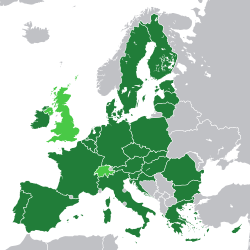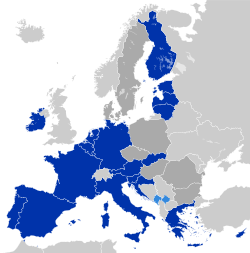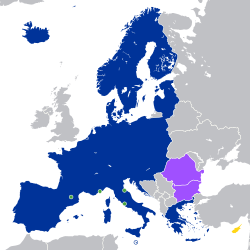2. Treaty
The Treaty itself consists of six articles. [66]
Article 1 arranges the accession of the Republic of Bulgaria and Romania to the European Union.
Paragraph 1 makes the Republic of Bulgaria and Romania full members of the European Union.
Paragraph 2 makes both countries parties to the Treaty establishing a Constitution for Europe and to the Treaty establishing the European Atomic Energy Community. Thus Bulgaria and Romania do not have to separately ratify the Treaty establishing a Constitution for Europe.
Paragraph 3 makes Protocol that sets the conditions and arrangements for admission and its annexes an integral part of the Treaty itself.
Paragraph 4 annexes the above-mentioned Protocol to the Treaty establishing a Constitution for Europe and to the Treaty establishing the European Atomic Energy Community and makes its provisions an integral part of these treaties.
Article 2 provides for the situation when the Treaty itself enters into force before the Treaty establishing a Constitution for Europe. Thus it will provide the legal basis of the membership of Bulgaria and Romania from 1 January 2007 until the Constitution of Europe is finally implemented in its present form (if ever).
Paragraph 1 states that both countries become parties to the Treaties on which the European Union is founded. Provisions of Article 1, paragraphs 2-4, will be applicable only from the date of entry into force of the Constitution of Europe.
Paragraph 2 states that, until the above-mentioned event, the conditions of admission and the adjustments to the Treaties on which the Union is founded will be provided by the Act annexed to the Treaty, which forms integral part of the Treaty itself.
Paragraph 3 arranges substitution of the Act with the Protocol upon the entry into force of the Constitution of Europe and legal consequences of this switch.
Article 3 defines all member states of the European union, including Bulgaria and Romania as equal in respect of all Treaties of the Union, including this one.
Article 4 is about ratification and entry into force of the Treaty.
Paragraph 1 stipulates that the Treaty should be ratified by all parties by 31 December 2006 and ratification instruments should be deposited with the Italian government.
Paragraph 2 and 3 define the data from which the Treaty enters into force, mechanism for eventual postponement in respect of one or both of the acceding states, and provides for the situation when one or more country has ratified the Treaty, but has failed to deposit the ratification instruments by 1 January 2007. The ratification procedures were completed in time and the Treaty entered into force on 1 January 2007 on the territory of all member states.
Article 5 stipulates that the Treaty establishing a Constitution for Europe drawn up in the Bulgarian and Romanian languages shall be annexed to this Treaty and they will be authentic under the same conditions as the texts in all other official languages of the European union.
Article 6 states that the Treaty exists as a single original drawn in all official languages of the European Union. Each of these texts is equally authentic and the original will be deposited with the Italian government, while all parties will receive certified copies.







